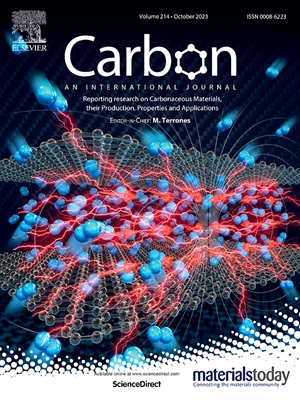Positron annihilation lifetime spectroscopy for ultramicroporosimetry of porous carbons
IF 11.6
2区 材料科学
Q1 CHEMISTRY, PHYSICAL
引用次数: 0
Abstract
Positron annihilation lifetime spectroscopy (PALS) has been used to analyse ultramicropore structures in silica-based porous materials. Energy-related applications increasingly demand improved characterisation of ultramicropore structures in carbon materials. However, PALS porosimetry has not been well established for porous carbons. Therefore, this study aimed to apply the PALS-aided ultramicroporosimetry to carbon materials. We employed single-walled carbon nanotube (SWCNT) bundles with tube diameters of 1.5 and 2.0 nm to determine the key parameter δ which reflects the collision between positronium and the carbon electron clouds and is an essential factor for analysing PALS data related to carbon materials. The SWCNT bundles featured two types of pores—internal tube spaces and interstitial subnanoscale spaces—which were characterised using X-ray diffraction. PALS measurements of these SWCNT samples yielded the parameter δ for carbon materials. The obtained δ was 0.23 nm. Using this value, we performed PALS analysis of reduced graphene oxide, which revealed the presence of pores approximately 0.13 nm wide. These pores are attributed to the staggered structure of GO prior to thermal reduction.

多孔碳的超微孔测定正电子湮灭寿命谱
正电子湮没寿命谱(PALS)已被用于分析硅基多孔材料的超微孔结构。能源相关的应用越来越需要改进碳材料的超微孔结构表征。然而,对于多孔碳,PALS孔隙度测定法尚未得到很好的建立。因此,本研究旨在将pals辅助的超微孔隙率测定技术应用于碳材料。我们采用直径分别为1.5和2.0 nm的单壁碳纳米管(SWCNT)束来确定反映正电子与碳电子云碰撞的关键参数δ,这是分析与碳材料相关的PALS数据的重要因素。swcnts束具有两种类型的孔隙-内部管空间和间隙亚纳米级空间-使用x射线衍射表征。这些swcnts样品的PALS测量得到了碳材料的参数δ。得到的δ为0.23 nm。利用该值,我们对还原氧化石墨烯进行了PALS分析,发现存在约0.13 nm宽的孔隙。这些孔隙归因于氧化石墨烯在热还原之前的交错结构。
本文章由计算机程序翻译,如有差异,请以英文原文为准。
求助全文
约1分钟内获得全文
求助全文
来源期刊

Carbon
工程技术-材料科学:综合
CiteScore
20.80
自引率
7.30%
发文量
0
审稿时长
23 days
期刊介绍:
The journal Carbon is an international multidisciplinary forum for communicating scientific advances in the field of carbon materials. It reports new findings related to the formation, structure, properties, behaviors, and technological applications of carbons. Carbons are a broad class of ordered or disordered solid phases composed primarily of elemental carbon, including but not limited to carbon black, carbon fibers and filaments, carbon nanotubes, diamond and diamond-like carbon, fullerenes, glassy carbon, graphite, graphene, graphene-oxide, porous carbons, pyrolytic carbon, and other sp2 and non-sp2 hybridized carbon systems. Carbon is the companion title to the open access journal Carbon Trends. Relevant application areas for carbon materials include biology and medicine, catalysis, electronic, optoelectronic, spintronic, high-frequency, and photonic devices, energy storage and conversion systems, environmental applications and water treatment, smart materials and systems, and structural and thermal applications.
 求助内容:
求助内容: 应助结果提醒方式:
应助结果提醒方式:


